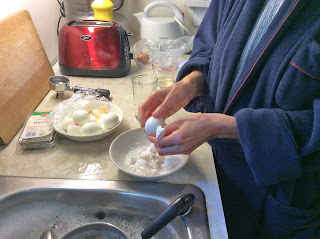 |
| The happiest picture I have of my parents. Taken in the months before their marriage 69 years ago, it reflects how happy they were to have found each other. |
 |
| Mom and dad on their wedding day. |
Sixty-nine years ago Wednesday, on Aug. 31, 1947, my mother and father were married in Wetaskiwin, Alberta. He wore a suit with a carnation in the buttonhole; she wore a blue hat, a navy dress with a ruffled collar and a corsage. Two friends "stood up" for them in the registry office, then the four of them went for lunch. There was no honeymoon.
Although they certainly weren't the only people in those post-war years to have a no-fuss registry wedding, it also said something about them. Two prairie farm kids of immigrant parents, they grew up as hard-working farm help, and survived the Dirty Thirties and the Second World War (dad was in the army; mom returned home to help on her parents' farm). By the time of their wedding -- mom was 27 and dad was 30 -- they had no illusions about what was important in life.
The only semi-romantic story I heard about their courtship was mom's tale of their first two encounters. They met in winter, at a dance in Red Deer, in late 1946 or early 1947. Mom loved dancing, and when she met dad, she liked his height and good looks, but most of all, she liked his voice. It was low-pitched and quiet, opposite to the constant high-pitched chatter of her father's household.
The second meeting was the clincher. On the night they had agreed on, it was viciously cold, so cold that both thought the other wouldn't show up (this was pre-cellphone, remember). The way mom told the story -- dad never talked about anything like this -- I got the sense that it was a revelation, a deal-maker, when they both realized the other was, first, interested enough to come, and second, tough enough to carry out the commitment.
I think those two elements were the basis of everything that followed. They cared for each other. And both knew they could depend on the other to persevere through whatever life threw at them -- crop failures, constant financial uncertainty, the death of dad's siblings, illnesses, and five growing children all with their own issues.
They never made a fuss about their anniversary. They rarely even mentioned it, at least to us kids. But mom's diaries show that once the kids were gone, they often did some special small thing to mark the day. In 1989, it was a little cruise boat trip from New Westminster to Fort Langley; in 1992, they went to Lynden and Bellingham, a favourite jaunt across the border. Often they had dinner out at a modest restaurant like Uncle Willy's buffet to conclude the day.
In 1994, on their last anniversary before dad died, and neither was very well, they made a big effort. "We drove up to Seymour Mountain, stopped at New West Quay," mom wrote. "Had supper at Knight and Day restaurant. Picked out the video,
Guess Who's Coming for Dinner."
Dad died in March of 1995. That year, mom's Aug. 31 entry was one line: "May (a neighbour) came and picked up the apples." The next year, she took flowers to the cemetery.
In the years after that, us children sometimes made an effort to see her on her anniversary, but she never made a point of talking about dad or saying the day was special to her. Aug. 31 was her and dad's day, and what it meant was between them.
 |
| Dad in his army uniform. He was taking a post-war training course when he met mom in Red Deer. |
 |
| Mom at about the time she met dad. |
 |
| Mom's simple gold wedding ring was so well-worn that it broke after many years. Mom and dad went out and bought another, which was lost in mom's final nursing home. |


































































